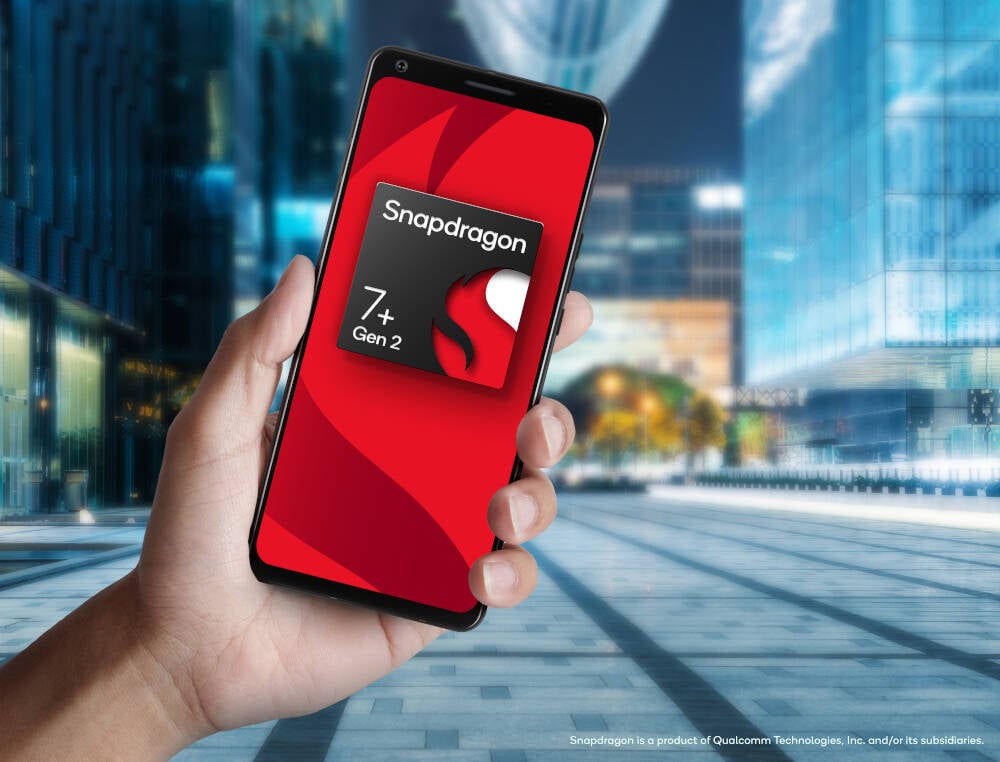Qualcomm Adds 'premium Experiences' To Snapdragon 7+ Gen 2

Qualcomm has launched the Snapdragon 7+ Gen 2 mobile platform, which it claims gives some of the bang of its high-end Snapdragon 8 series, but for handsets carrying a less hefty price tag.
According to the mobile chipmaker, the Snapdragon 7+ Gen 2 offers up the usual improvements smartphone buyers have come to expect, including performance gains across the CPU and GPU, as well as better power efficiency.
The new chipset replaces the existing Snapdragon 7 Gen 1 as Qualcomm’s “high tier” smartphone platform, targeting handsets in the $400 to $600 range. But for the avoidance of confusion, that doesn’t make it the company’s top-of-the-line brand, which is instead the “premium” Snapdragon 8 series.
Qualcomm director for Product Management, Cindy Lei, told us: “We bring together the best in class technology in our Snapdragon 8 series, and that shapes the way our users play, interact and express themselves. And then we take select premium experiences, and we bring them into our other Snapdragon tiers so everybody can enjoy the power and the promise of Snapdragon excellence.”
Qualcomm claims to have 69 percent of the global “high tier” market with its Snapdragon chips, by the way, plus 78 percent of the “premium” tier.
The CPU block in Snapdragon 7+ Gen 2 features Qualcomm's Kryo cores in a 1-3-4 arrangement, with one prime core, three performance cores and four efficiency cores, clocked at up to 2.91GHz. This delivers up to 50 percent more performance than its predecessor, Qualcomm claimed.
Meanwhile, the Adreno GPU in this SoC provides twice the performance, and also doubled is the AI performance of the whole chip, thanks to enhancements in the CPU, GPU and the integrated Qualcomm Hexagon digital signal processor (DSP). Qualcomm also claims a 13 percent improvement in power efficiency across the system for extended daily use.
Connectivity is provided by an integrated Snapdragon X62 5G Modem-RF System, claimed to offer download speeds of up to 4.4Gbps, while FastConnect 6900 supports Wi-Fi 6 and 6E for speeds up to 3.6 Gbps, plus Bluetooth 5.3.
What these features are intended to deliver is a better smartphone for the end user, and Qualcomm claims that the improvements in the Snapdragon 7+ Gen 2 mean a better “experience” in several areas.
This includes lossless CD quality music thanks to the adaptive aptX technology, while for image capture, this chip includes the 18-bit image signal processor (ISP) introduced in the Snapdragon 8 series, providing improvements in dynamic range and HDR capability, Qualcomm said.
It also supports mega low light mode for night-time photography, where the camera can take 30 shots and merge all the best parts into one brighter and clearer final image.
For game players, Snapdragon 7+ Gen 2 now supports auto variable rate shading (VRS), described as a feature that better allocates resources to reduce GPU workload without sacrificing graphical fidelity. It also supports volumetric rendering, and the Adreno Frame Motion Engine, which is claimed to generate more frames so as to double the frame rate without using any additional power.
One interesting capability in Snapdragon 7+ Gen is support for 5G/4G Dual-Sim Dual Active (DSDA), which enables the use of two simultaneous SIMs.
- The US would sooner see TSMC fabs burn than let China have them
- Qualcomm tries to kick holes in logic behind €242M fine
- 200MP smartphone and first premium PC spearhead Samsung's pro push
- Europe trims Apple App Store probe after deciding in-app payments not a problem
- Qualcomm claims to be 5G Advanced-ready with Snapdragon X75
“This allows you a foreign SIM when travelling without having to give up your local SIM, or you can have separate business and personal numbers on the one phone,” Lei said.
Qualcomm said that commercial smartphones with the Snapdragon 7+ Gen 2 platform are expected to be launched this month, mentioning Redmi and realme as OEMs that will have devices ready.
Qualcomm last month reported a 12 percent year-on-year drop in revenue for the first quarter of its 2023 financial year, blamed on weakened global demand in the smartphone market. ®
From Chip War To Cloud War: The Next Frontier In Global Tech Competition
The global chip war, characterized by intense competition among nations and corporations for supremacy in semiconductor ... Read more
The High Stakes Of Tech Regulation: Security Risks And Market Dynamics
The influence of tech giants in the global economy continues to grow, raising crucial questions about how to balance sec... Read more
The Tyranny Of Instagram Interiors: Why It's Time To Break Free From Algorithm-Driven Aesthetics
Instagram has become a dominant force in shaping interior design trends, offering a seemingly endless stream of inspirat... Read more
The Data Crunch In AI: Strategies For Sustainability
Exploring solutions to the imminent exhaustion of internet data for AI training.As the artificial intelligence (AI) indu... Read more
Google Abandons Four-Year Effort To Remove Cookies From Chrome Browser
After four years of dedicated effort, Google has decided to abandon its plan to remove third-party cookies from its Chro... Read more
LinkedIn Embraces AI And Gamification To Drive User Engagement And Revenue
In an effort to tackle slowing revenue growth and enhance user engagement, LinkedIn is turning to artificial intelligenc... Read more

